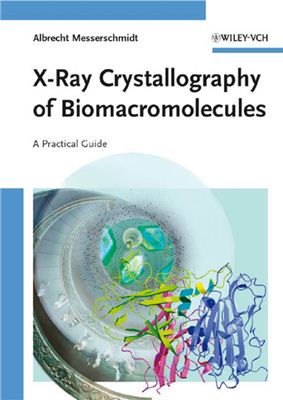Wilеy-VСH Verlag, Weinheim,, 2007, 304 pages
Knowledge of the atomic structure of biomacromolecules such as proteins, nucleic acids and carbohydrates is indispensable for an understanding their biological function. The sequencing of whole genomes from bacteria to man has provided the possibility to clone and express their gene products, which in most cases are proteins. The new field of Structural Genomics, or its synonym Structural Proteomics, aims at determining the three-dimensional structures of the whole set of gene products – the so-called targets – or of a biological or medical important subset of targets. X-ray crystallography is the major technique to determine the atomic structure of biomacromolecules. This book provides the theoretical basis and covers the experimental techniques of X-ray crystal structure determination of such molecules. It documents the state-of-the-art of this method, including practical case studies. It will be of excellent use for students and researchers active in this field, and will also serve as source of information for readers from other related research areas.
Written by one of the most significant contributors to the progress of protein crystallography, this practical guide contains case studies, a troubleshooting section and pointers on data interpretation. It covers the theory, practice and latest achievements in x-ray crystallography, such that any researcher in structural biology will benefit from this extremely clearly written book.
Part A covers the theoretical basis and such experimental techniques as principles of x-ray diffraction, solutions for the phase problem and time-resolved x-ray crystallography.
Part B includes case studies for different kinds of x-ray crystal structure determination, such as the MIRAS and MAD techniques, molecular replacement, and the difference Fourier technique.
Knowledge of the atomic structure of biomacromolecules such as proteins, nucleic acids and carbohydrates is indispensable for an understanding their biological function. The sequencing of whole genomes from bacteria to man has provided the possibility to clone and express their gene products, which in most cases are proteins. The new field of Structural Genomics, or its synonym Structural Proteomics, aims at determining the three-dimensional structures of the whole set of gene products – the so-called targets – or of a biological or medical important subset of targets. X-ray crystallography is the major technique to determine the atomic structure of biomacromolecules. This book provides the theoretical basis and covers the experimental techniques of X-ray crystal structure determination of such molecules. It documents the state-of-the-art of this method, including practical case studies. It will be of excellent use for students and researchers active in this field, and will also serve as source of information for readers from other related research areas.
Written by one of the most significant contributors to the progress of protein crystallography, this practical guide contains case studies, a troubleshooting section and pointers on data interpretation. It covers the theory, practice and latest achievements in x-ray crystallography, such that any researcher in structural biology will benefit from this extremely clearly written book.
Part A covers the theoretical basis and such experimental techniques as principles of x-ray diffraction, solutions for the phase problem and time-resolved x-ray crystallography.
Part B includes case studies for different kinds of x-ray crystal structure determination, such as the MIRAS and MAD techniques, molecular replacement, and the difference Fourier technique.

